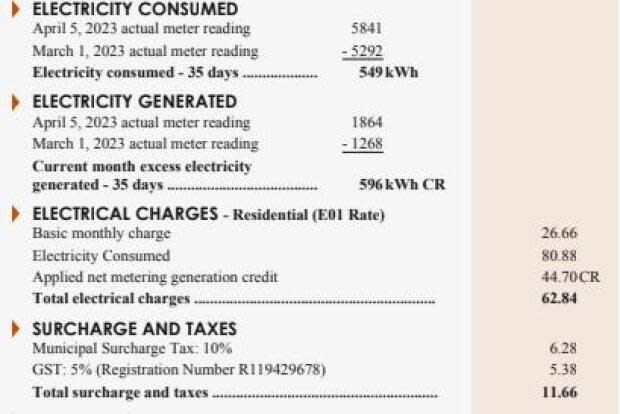SaskPower customer unhappy about bill after generating more solar power in month than she used

Tera Ebach installed solar panels on her Saskatoon home to lower her ecological footprint. She wishes her power provider had more attractive measures to entice others to do the same.
Ebach is part of SaskPower's net metering program — which allows customers to generate their own electricity with solar panels and receive credit for any excess they generated for the provincial grid.
From March 1 to April 5, she produced more power with her solar panels than she used — meaning she overall ended up providing power to the utility company — but still ended up having to pay $74.50 on her monthly bill.
"Part of the reason for getting the solar panels is to reduce my expenses by using renewable energy," Ebach said.
"I think it's really important that SaskPower look at an option which is maybe not the absolute most profitable [option], but something that is going to do the most amount of good for the most amount of people."

'A system that does not encourage people to sign up'
Switching to solar power hasn't been cheap for Ebach. After incentives, she paid $9,000 to install 14 solar panels on her roof.
Ebach said she then had to pay hundreds of dollars to apply to be part of the net-metering program and to switch out her old meter.
Through the current net-metering program, any excess energy sent to the grid is credited at 7.5 cents/kWH. This is about half of what the previous iteration of the program paid.
Ebach says she understands there are costs to maintaining SaskPower infrastructure, but thinks the current net-metering rates are unfair.
"It seems like it's a system that does not encourage people to sign up for it, " Ebach said
"Instead of where they [SaskPower] are getting a 50 per cent margin, maybe it should be more like a 25 per cent margin, or just something more comparable. I think there would be a lot more uptake from people wanting to get involved in the program and it's a way to reduce fossil fuel consumption like gas power. "

Ebach called SaskPower to complain about her rates. She said the response she got from a manager was shocking.
"He was very point blank about how [SaskPower] lose money from homeowners having solar panels, so we've got no interest in making our net metering program attractive to people," Ebach said.
Previous system wasn't sustainable: SaskPower
Nathan Hoffart, SaskPower's manager of customer solutions, said the Crown corporation changed its net metering rates because the previous iteration was unsustainable and non-net metering customers had to pay for the deficit.
"We just have to manage our costs," Hoffart said. "We're accountable to all customers in the province. We need to make sure that we are providing good value to net-metering and not-metering customers alike."
SaskPower said that if it continued the previous net-metering rate, and the program continued growing at the rate it had, the it would cost the Crown corporation $54 million by 2025.
Hoffart said customers who generate solar power still need SaskPower infrastructure during times when the sun isn't out.
"Offsetting all of your costs means you're not paying into the upkeep of the grid which you still rely on," Hoffart said.
Hoffart said residential solar power is part of the "bucket of options" to help SaskPower achieve net zero-emissions, but that larger scale solar facilities are more cost effective.

The difference between Saskatoon's power providers
There are two power providers in Saskatoon. Which one supplies a home depends on where it is in the city.
Saskatoon Light & Power (SL&P), run by the city, provides service within the 1958 city boundary, except for the University of Saskatchewan which is jointly serviced.
SL&P has a one-to-one net metering program, meaning that if customers generate more electricity than they need, the difference is awarded as a 1:1 credit on their account.
That means excess power generated in one month can offset the bills in another.
Jose Cheruvallath, SL&P metering and sustainable energy manager, said the company is facing some of the same sustainability challenges as SaskPower.
"However at this time council has decided against making that change, and part of that was to ensure we continue to incentivize participation in the program," Cheruvallath said.
"Part of it also had to do with the city's targets for greenhouse gas reductions, which were recently updated to being net-zero by 2050, and I guess the city is [anticipating] some of those savings coming from net-metering participation."
Cheruvallath added that it's important for cities to promote solar panels on roofs, because there often isn't much room for larger scale solar facilities.
"We have a monumental task ahead of us in cleaning our electricity grid," he said. "This will require a collaborative and community effort to be successful."


